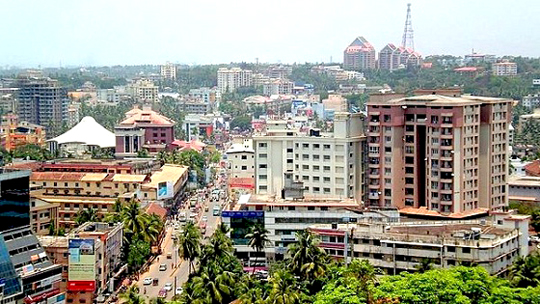Air pollution has emerged as one of the deadliest environmental health risks ever. Millions of people die every year because of the constant exposure to polluted air. Out of the 6-7 million premature deaths each year due to air pollution, more than 50% of those occur in China and India alone. Air quality has a strong influence on India's capability to sustain high economic growth, but the national policies has treated the issue with insubstantial importance.

A new report from Greenpeace foundation, based on NASA's satellite data indicates that people living in some parts of India are at a higher risk of health problems linked to depleting air quality than those living in China. According to WHO report, half of the world's 20 most polluted cities are in India. As per a geophysical research, air pollution is 5th largest cause of deaths in India which includes diseases like chronic obstructive pulmonary disease, ischemic heart disease, low respiratory infections and trachea, bronchus, lung cancer. The major reasons behind air pollution in India are biomass burning, emission from vehicles, thermal power plants and industries.
Mangaluru, a major commercial center in the state of Karnataka, has witnessed a drastic change over the years. A study conducted in 2009 by Central Pollution Control Board, Mangaluru, was regarded as the most polluted industrial city of Karnataka, where pollution had touched thecritical' level. The main reason was the establishment of SEZ (Special Economic Zone) and other petrochemical industries.
Now, the entire scenario has changed, in terms of air quality due to the cohesive efforts of the Karnataka State Pollution Control Board (KSPCB) and the local residents of the Baikampady industrial area. “The authorities measure the air quality for particulate matter 10, 2.5 using equipment like the RespirableDust Sampler and High Volume Sampler which has separate units for measuring nitrogen dioxide, sulphur oxides and various other pollutants,” said Jayprakash Nayak, a senior scientific administrator at KSPCB. He also added, “The recent reports and tests show that the air quality in Mangaluru is considerably below thecritical' level prescribed by the Ministry of Environment, Forest and Climate change. Since Mangaluru is a coastal city, there is enormous effect of the Arabic sea on the environment especially, the atmosphere. The East-West patterned winds carried out by the sea, takes away the polluted air towards the Western Ghats. But it doesn't mean that the entire process of cleaning the air is done by the Mother Nature.”
Nayak continued, “Mangaluru, being an industrial belt, the air quality is far better than that of metropolitan cities like Bengaluru, Mumbai, Delhi and Kolkata. The changes in the environment and air quality are evident due to the strict rules and regulations imposed on the industries by KSPCB in Mangaluru. Under this, separate stalk monitoring units have been installed at the processing outlets of industries. Before the establishment of industries, it has to undergo preliminary tests and environment impact assessment. The industries have to obtain the license on a yearly basis. It is mandatory for an industry to have 33% of its area as green belt. Due to these rigorous laws, the air pollution is under control and the air quality is recuperating gradually. The industrial pollution in Mangaluru has come down due to the introduction of modern technology as well as moving industrial units away from the masses.” KSPCB also claims that the health issues among people living in the industrial areas has reduced and at present there are no ill-effects on the health due to emission from the industries.
“There have been cases of cough, minor respiratory issues and skin problems especially with children. We believe that these problems are caused by the industries situated in our area,” said Suresh Katheel, a resident of Baikampady industrial area. Muhammed Nayeem, a shopkeeper in the area had this to say “The dust present here is increasing day by day and it is becoming difficult to breathe.” Many other residents of this area, were also of the same opinion. To this claim, Nayak responded, “The people living in the industrial area blame the industries and KSPCB for these problems but the doctors and the KSPCB cannot justify it as the result of pollution caused by the industries due to lack of research and scientific proof.”
Nayak said, “Apart from the industrial area, the air pollution in the city is under control. The main reason for air pollution in the city is emission from vehicles. The vehicular air pollution accounts for about 66% of the total pollution, where 44% is from smoke and the remaining 22% from the road dust. While the industrial air pollution and construction activities makesup about 14% each.” Nayak continued about the emission rules set by the central government which has been implemented for the vehicles in the city. It is monitored by the RTO with the help of KSPCB. “It is mandatory for the vehicles to run on Euro 4 stage of emission and is expected to be Euro 6 by 2020. The district administration wants to ban the usage if kerosene in vehicles completely to decrease its effects on the environment and recommends usage of CNG. Usage of public transport, cycling and carpooling should increase, which would bring down the number of private vehicles, thereby reducing levels of air pollution,” Nayak finished.
While air pollution has been effecting each and every individual, its only later that the subject has got the right attention from the policy makers and public at large. Educating the masses and spreading awareness on the effects caused by polluting the atmosphere is the first step towards a collective approach in finding solutions wherein everyone contributes to contain this problem. Air pollution is not an issue that can be addressed in isolation by an agency or government. Each and every individual needs to contribute towards a larger good and pure air.




Comments
Add new comment